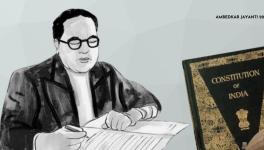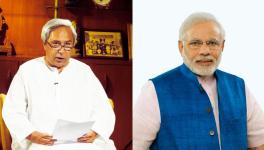Diary of an Indian Uprising
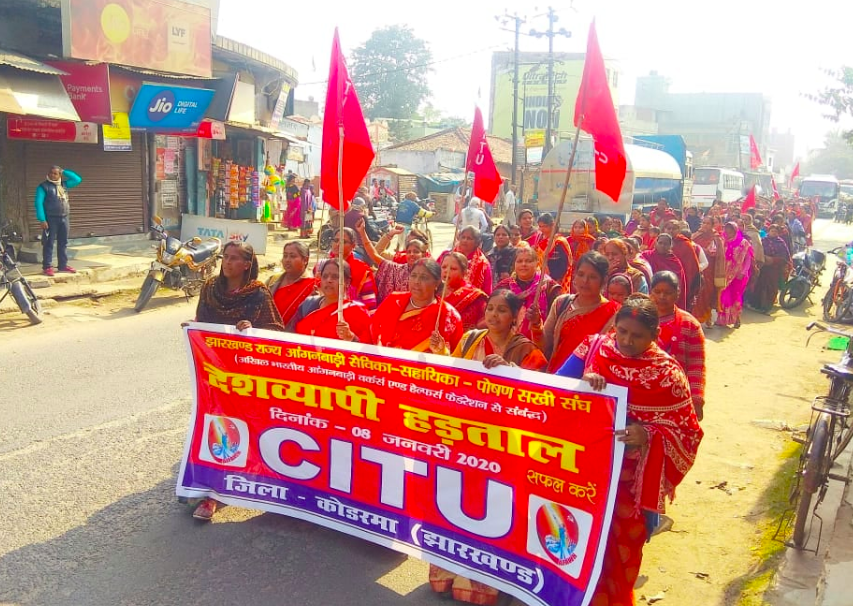
Scheme Workers in Jharkhand take out a procession to observe All India Strike
India is deeply polarised: one side in complete harmony with the policies of the far-right government of Narendra Modi, and the other side in complete disregard for the government and its atrocities. The country has never felt so divided, the tensions so palpable.
Fear
A Muslim man who sells bottled water near Rabindranath Tagore’s house in Jorasanko (Kolkata, West Bengal) tells me that his family came from Bihar about forty years ago. They left behind the small amounts of land they held because they felt threatened by their neighbours. The last thing that they worried about were their documents – birth certificates, land titles; they fled with their lives. This man – Shahabuddin – has children and grandchildren. The far-right government’s push for the National Register of Citizens, National Population Register, and the Citizenship Amendment Act suggested to Shahabuddin that he must assemble his documents. ‘Why do you need these documents?’, I asked. ‘If I don’t have them’, he said with a twinkle in his eye, ‘they will throw us out or kill us’.
Shahabuddin knows that these polices – the NRC, the NPR, and the CAA – are designed to target Muslims. There are 200 million Muslims in India. It is impracticable for the Indian State to either deport or murder all these people. Shahabuddin knows that the point of the entire far-right policy is not for him to present his documents to a bored bureaucrat in a crumbling building; the point is to make people like Shahabuddin and his entire family fearful, and to not assert themselves in society. The point is to make them feel like second-class citizens, to crush the spirit of a large section of the Indian population.
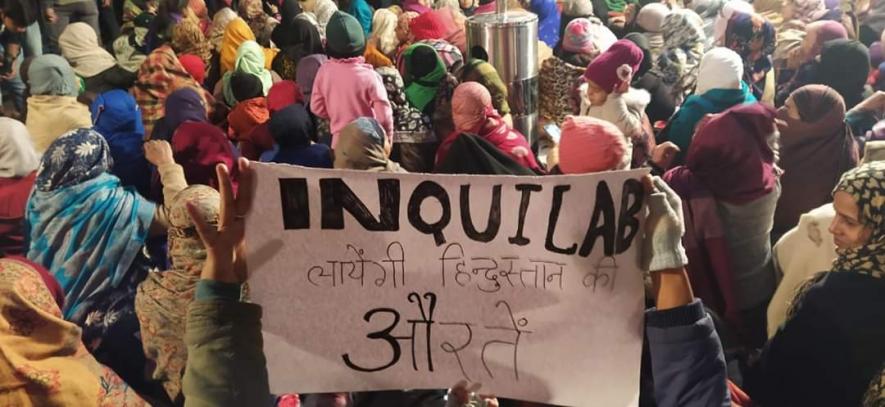
Protesters hold placards in Shaheen Bagh of Delhi during sit-in against CAA/NRC
Ever since Modi won re-election, he has pushed a hard edge policy against Indian Muslims. That is the focus of his social agenda. All the talk of Swachh Bharat (Clean India) and other such liberal manoeuvres fell by the wayside. The fangs bared, the attack on Kashmir led the way, that region now under permanent curfew and suffocation. Then it went out from there towards the new law on citizenship.
Classical liberalism suggests that the democratic sensibility is measured by how a State protects its minorities. Democratic Constitutions have all been aware of the ‘tyranny of the majority’, setting barriers to majoritarianism through laws and regulations that protect minority rights and cultures. These laws and regulations have been essential for the widening of democracy in society, as Dr. B. R. Ambedkar knew when he formulated the Indian Constitution (1950). But the far-right’s democracy is premised not on these protections but on their destruction. It seeks to inflame the majority against the minority in order to bring the masses onto its side, but not to allow the classes within them to develop their own politics. The far-right has no fealty to the traditions and regulations of liberal democracy. It will use the institutions as long as they are useful, poisoning the culture of liberalism which had serious limitations, but which at least provided space for political contestation. That space is now narrowing as a very violent defence of the far-right is increasingly becoming legitimised.
Gangsters
On 5 January, messages of great urgency came from comrades inside Jawaharlal Nehru University (JNU) in New Delhi. The university grounds had been closed, and masked gangsters from the far-right student union (the ABVP), affiliated to the ruling party, walked around with iron rods and targeted left-wing leaders of the student union (JNUSU). JNU has been the epicentre of a long struggle to defend both public education and to defend rational thought. The far-right government has longed to privatise higher education; a sharp instrument was the policy to raise fees for students. The #FeesMustFall mobilisations spread across the country and galvanised student opposition not only to this policy but to the general demeanour of the government towards society. It is one of the tenors of the far-right to promote mysticism and irrational thought. Fake historical accounts help the far-right to deny its role as collaborators with British colonialism and its subordinate character to US imperialism. It also helps them fantasise about an India without Muslims.
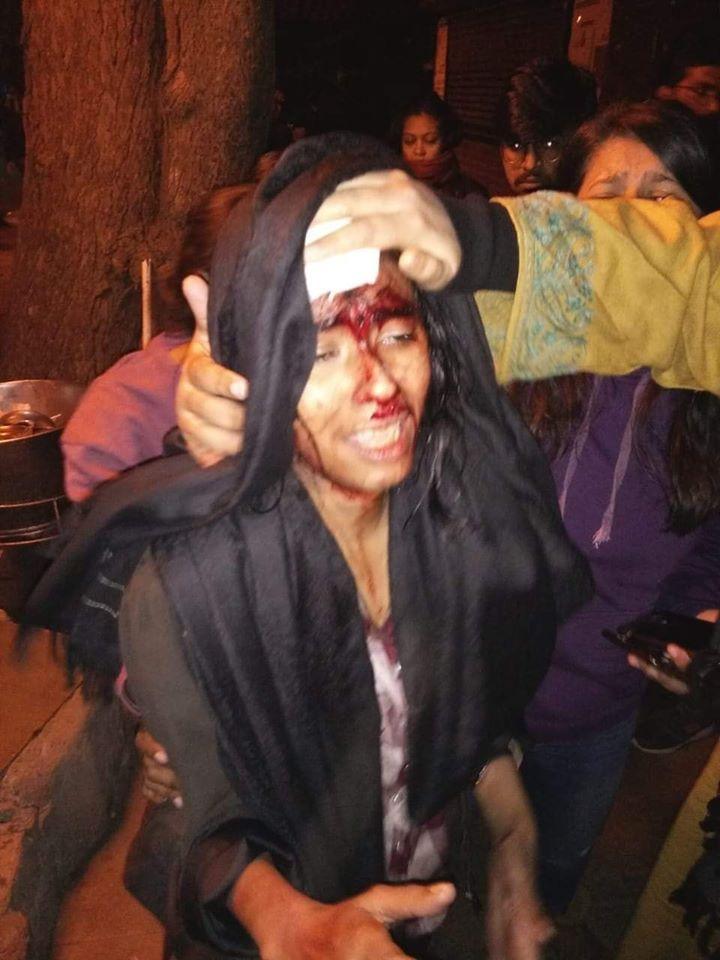
JNU Students Union President Aishe Ghosh was brutally beaten up by the masked goons
Over the course of these past few years, left student groups have been sweeping union elections across the country. Unity amongst different left groups has been essential to his wave, which has gone from one end of the country to the other. At JNU, the far-right was clobbered in the last election, and the left won; this left slate, led by Aishe Ghosh of the Students Federation of India, has fought on the campus for the basic needs of students (including lower fees) and for broader political questions (such as to defend rationality). It is emblematic of the far-right to champion both unregulated capitalism and maddening mysticism, the Adani-Ambani empires on the one side and ‘ghost studies’ and ‘urine therapy’ on the other. There is no contradiction for the far-right, which drowns a society in mystical thought to prevent resistance to its donation of social wealth to the minuscule affluent population.
The campus security forces at JNU stood down as the gangsters of the far-right wielded iron rods and hammers, their WhatsApp groups telling them where to go and who to beat. The target was always the left student leaders; Ghosh was beaten mercilessly. The Delhi Police was called but waited at the main gate, the pretext being that they did not have permission to enter the campus; no such permission was sought when the Delhi Police weeks earlier had barged onto the Jamia Milia Islamia University grounds, chasing students into the library and into toilets, bashing them to an inch of their lives. This was the State in collusion with the thugs of the far-right, the left the primary target.
Home Minister Amit Shah, Modi’s hammer, controls the Delhi Police. Their behaviour has all the marks of a whisper from above. Indeed, not much needs to be interpreted here. Days after the terrible violence at JNU, Shah gave a speech where he blamed the left for the violence. ‘Shouldn’t students who raised anti-India slogans be put behind bars?’, he asked as if innocently. The ‘anti-India’ slogan he has in mind is the simple word Azadi. It had been shouted on the JNU campus in 2016 at a protest meeting against the execution of two Kashmiris by the Indian State. It has now morphed into a general barometer of protest. Shah’s party had charged the then JNU president Kanhaiya Kumar, and several others, with sedition. The BJP coined the term ‘tukde tukde gang’ after this incident – the term referring to those who want to break up India or, as the BJP loves to put it, anti-nationals; this term is now used by the BJP, and Shah in particular, to refer to any dissent in India.
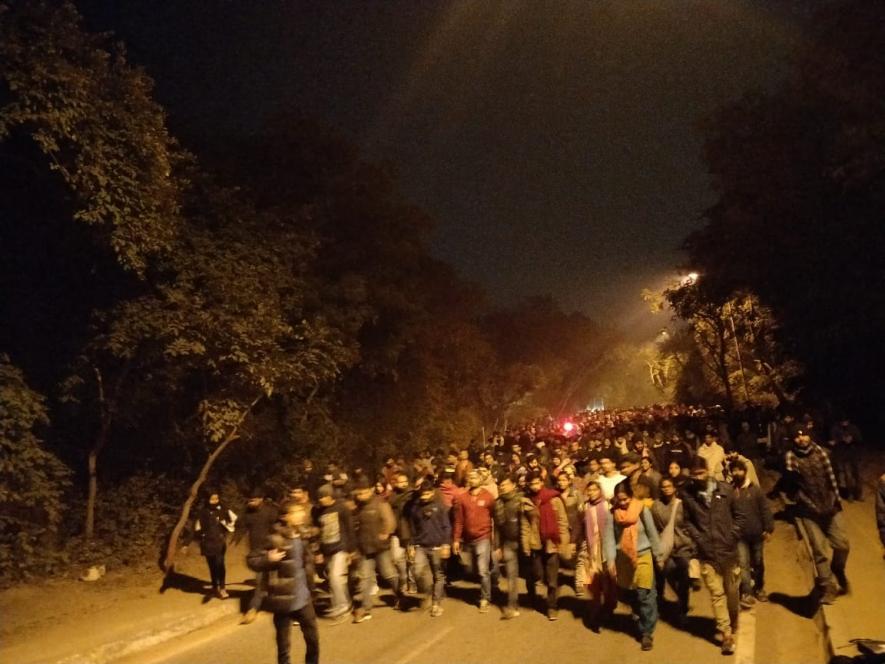
JNU students march against the attack on the university
Shah had no remorse for the violence. Shah’s Delhi Police did not seem interested in the far-right masked gangsters; they filed a case against the survivor, Aishe Ghosh. It is typical of the far-right to blame the left for violence, and this is what they have done. Rather than comment at length on this incident, which has rattled students and teachers, indeed many Indians, Shah has continued to talk about building a ‘sky-high’ temple in Ayodhya on the site where his confederates had destroyed a 16th century mosque in 1992 (the land recently turned over to the far-right to build this Mount Meru of the Hindutva imagination).
Disobedience.
On 7 January, college students and teachers marched from Kolkata’s College Street to the home of Rabindranath Tagore. They fashioned themselves as Students Against Fascism as they sang and chanted along the streets. Even here, the songs of azadi gripped the air, the tension of the slogan now turned into disobedience and joy. The students sang against hunger and caste, against gender oppression and Hindutva, against capitalism and poverty – and they sang, as they are singing all over India, that they want azadi or freedom from these maladies. Fear is banished in these gatherings, and disobedience is the key sensibility.
Across the country, at Mumbai’s Gateway of India, the songwriter Puneet Sharma coined perhaps the poem that best captures this disobedience – tum kaon ho be, who are you? This poem is directed at Modi and his regime. I have a direct relationship to India, he opens his poem; who are you to question me? As he opens his poem, the people sitting around him laugh. There is no fear. Who the hell are you – they are asking Modi and Amit Shah; who are you to tell us what to do, to poison our society, to bully us into submission?
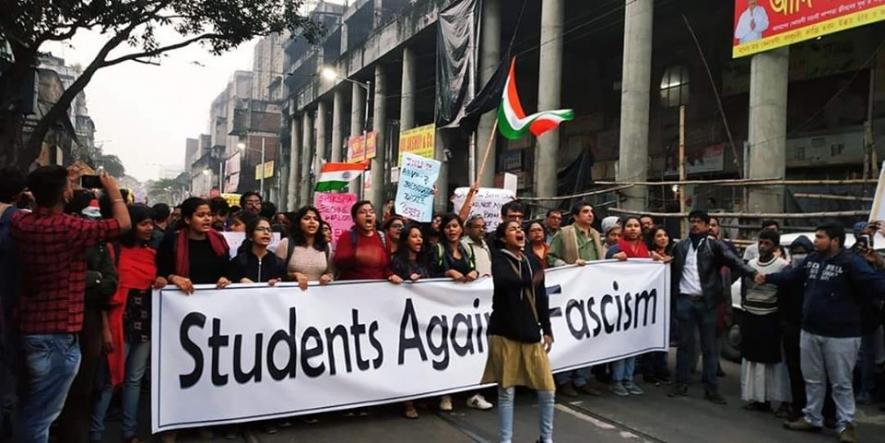
An older poem by Faiz Ahmed Faiz, hum dekhenge, we shall bear witness, carries the same tone of disobedience and creativity. Students at the Indian Institute of Technology (Kanpur) faced serious consequences from the administration for reciting this poem written in 1979 and written against the dictatorship in Pakistan. When Iqbal Bano sang this poem in 1986 in Lahore, and when she got to this verse below, the crowd erupted in cheers of Inquilab Zindabad – long live revolution:
Their crowns will be flung in the air.
And their thrones will be smashed.
Who are you to ask me anything, who are you whose thrones will be smashed – the creative disobedience marks the mood of the protests, joy and hope the stamina to come back each day, complete disregard for the system, defiance for the order of things, inspired by each other to imagine immediately a different way to live. Not one inch is the formula from JNU after the attack; not one inch is the sense from College Street to the Gateway of India.
It is this defiance that marks the Muslim women who began a protest in Delhi’s Shaheen Bagh, one that is now mirrored in Kolkata’s Park Circus Maidan. These are women who come to politics because of the malicious politics of the BJP. They fear for the lives of their communities, of the fear that has begun to keep their children up at night. These are brave people, since they have blocked roads and have decided to remain their indefinitely; what is the point of going home, they say, if our homes are being threatened by the bulldozers of the BJP’s new policies? These occupations of public space might be motivated by fear, but they develop into places of great creativity, the singing and the drawing, the slogans and the smiles on the faces of the children a mark of what is to come after the thrones will be smashed. There is revolutionary creativity in the air; new boldness is being produced, which will remain long after the iron rods and the water cannons and the jail cells vanish into our distant memory.
Class Struggle.
For the past several years, ten Indian trade unions have gathered together to hold a general strike in January. Last year’s strike brought out 180 million people – most of them informal sector workers – on a charter of twelve demands. These are elementary demands, asking for basic rights and a better share of social wealth; the workers are worried about the IMF-driven ‘labour market reforms’ which is code for destroying trade unions and government regulations over the entire capitalist system.
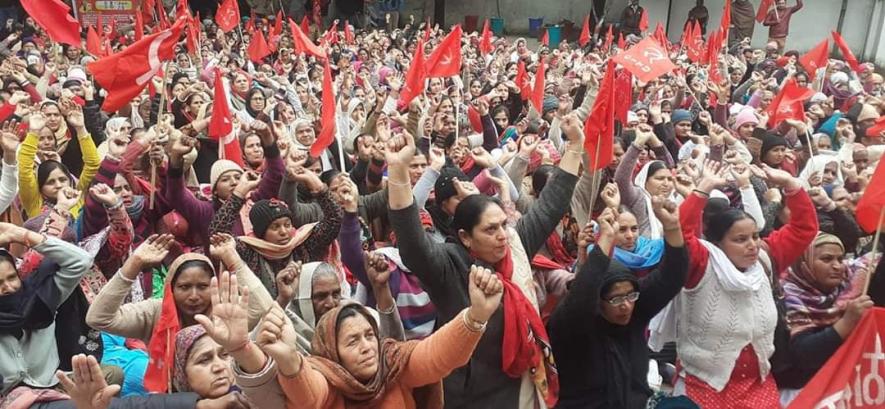
There is good reason for the workers and peasants to be angry. A National Statistical Office document – Key Indicators: Household Consumer Expenditure in India – showed that for the first time in forty years real per capita household expenditure in India had fallen. The BJP government was so annoyed with this report that it threw it out. Then, on 27 December 2019, the Niti Aayog (formerly the Planning Commission) of the government produced its Sustainable Development Goals Index for 2019. Stunningly, the index showed that over the past two years income inequality has grown, and so have hunger and poverty. The most stunning part of the report is its ‘Conclusion and Way Forward’; it says nothing, no analysis of why these are increasing, no indicator of what the government is going to do about it. Here is language without meaning, a taste sufficient to dull the mind: ‘NITI Aayog will continue to play the role of a catalyst, facilitator and enabler to ensure that the implementation process moves on a fast track towards the full achievement of the Sustainable Development Goals’. Here is a government willing to use meaningless dead phrases (catalyst, enabler, fast track) without any analysis of something so serious as hunger and poverty.
This year, given the anger at the ‘citizenship’ debate, the unions added a thirteenth demand – withdraw the new law and stop the population registry. The General Strike of 2020 was not going to be a worker strike alone this year, but a massive unified strike of workers, peasants, and students. On 8 January, therefore, close to 25 crores (250 million people) went on strike, marched on the streets, and sang songs of disobedience. This is now the largest general strike in world history.
As the first unions began to stop trains, the television media began its barrage about inconvenience. The middle-class is paralysed with fear of being inconvenienced, perhaps its highest aspiration is to have no traffic for the drive to work and no queues at any shop or office. So to pluck as the strings of inconvenience colours how the middle class sees the strike. But the students from the middle-class had a different attitude this year, an attitude marked by their disobedience.
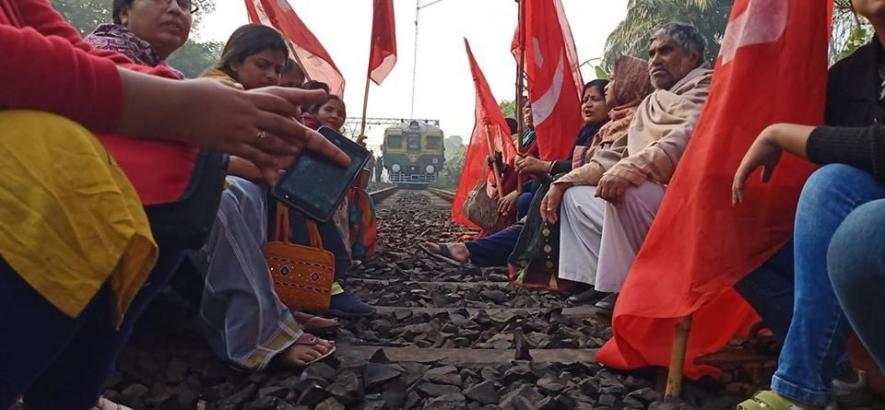
The bourgeoisie is always indignant that the workers have inconvenienced society; but it is the bourgeoisie that has inconvenienced humanity.
Capitalism is class war. Each day workers struggle against a structure that dehumanises them and uses their social labour to accumulate on behalf of the propertied. When workers strike, they stake out an active position in a class struggle that they do not initiate. The Indian General Strike is a statement by workers, peasants, and students that they will not subordinate themselves permanently to the class rule of the bourgeoisie. It is important to underline that the class struggle is imposed upon workers. A general strike - the holiday of the workers - is an action to remind society that it is workers who produce social labour and that workers make a claim on society against the class rule of the bourgeoisie. This is a testing ground on the class struggle.
Question
What is the point of being alive if you do not want to make the world a better place?
Get the latest reports & analysis with people's perspective on Protests, movements & deep analytical videos, discussions of the current affairs in your Telegram app. Subscribe to NewsClick's Telegram channel & get Real-Time updates on stories, as they get published on our website.















